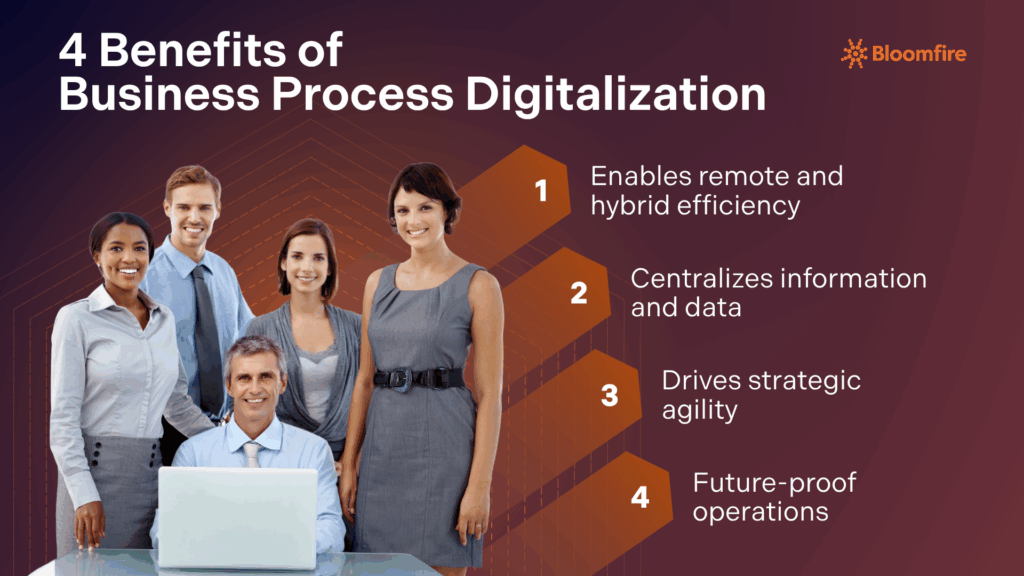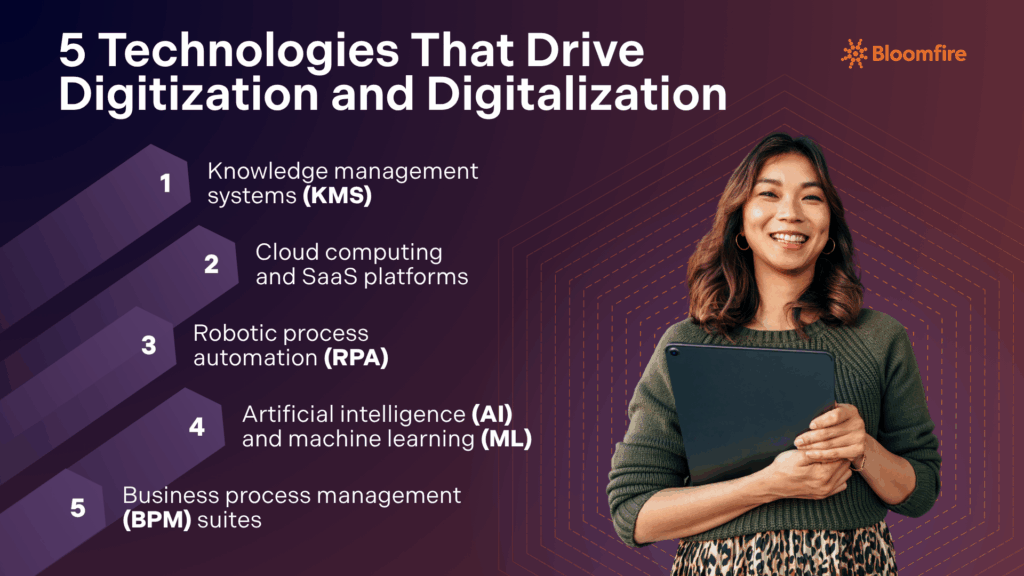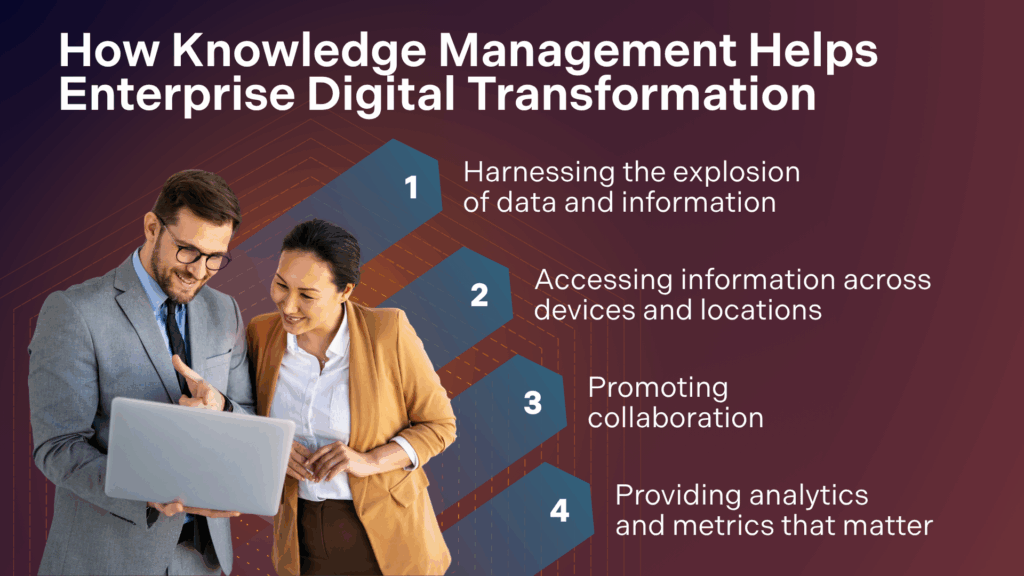Digitalization and Digitization of Business Processes (+How They Drive Digital Transformation)

SUMMARY: Digitization of business processes is the foundational step of converting analog information into a machine-readable digital format, making data more accessible and easier to manage. Digitalization then builds upon this by strategically using that digital data and technology (like AI and automation) to transform entire business processes and create a more efficient, agile, and higher-value digital business model.
“Digitization” and “digitalization” have been buzzwords for more than a decade, but these terminologies remain strong for a reason. Digitization and digitalization have become bigger priorities than ever as businesses shift towards hybrid work models and customers increasingly embrace online channels.
Let’s take a closer look at what these terms mean and how knowledge management and Enterprise Intelligence play critical roles in digital transformation initiatives.
Defining the Digital Terms: Digitization Vs. Digitalization of Business Processes
The terms “digitization” and “digitalization” are often confused, yet they represent two fundamentally different stages in a company’s technological evolution. Understanding this distinction is essential because it separates a basic technological upgrade from a true, transformative business strategy. It will allow you to sort out your priorities–to digitize or digitalize?
| Feature | Digitization | Digitalization |
|---|---|---|
| Goal | Make information accessible. | Make processes efficient. |
| Scope | Converting an individual item (e.g., a document). | Transforming entire systems and workflows. |
| Impact | You’ll have a “digital workplace.” | You’ll have a “digital business model.” |
| Primary Value | Preservation and basic data retrieval. | Automation and operational fluidity. |
| Technology Use | Simple scanning, storage, and file formats (PDFs). | Advanced software, RPA, AI, and workflow systems. |
The fundamental similarity between digitization and digitalization is that both rely on digital technology to improve how a business handles information and tasks. Both processes are essential stepping stones toward the ultimate goal of comprehensive digital transformation in business process management..
However, the crucial difference lies in the scale of the outcome: digitization is a narrow, tactical step focused on changing the format of information (e.g., paper to file), making it machine-readable. In contrast, digitalization is a broad, strategic action focused on using that digital data to transform the process itself (e.g., automating routing and approval). This alters the organizational structure and creates higher-level value through automation and intelligence.
What Is the Digitization of Business?
According to the Business Dictionary, digitization is the conversion of analog information into a digital form using suitable electronic devices, allowing data to be processed, stored, and transmitted through digital circuits, equipment, and networks.
Put simply, digitization is the process of converting information into a digital format, a concept that is by no means new. The digitization of business leads to a more digital workplace. Often, leaders mistake this as meaning simply an absence of paper, but it can mean so much more. For some organizations, it can mean a different style of work, such as accessing information from mobile devices in the field and collaborating with remote workers in new ways. These process changes require more than just replacing paper documents with digital ones.
Core Benefits of Business Process Digitization
The initial conversion of data from paper or analog formats is the foundational step that unlocks future strategic growth. This simple yet critical process immediately transforms information from a static, physical asset into a dynamic, flexible resource. Specifically, it benefits cover the following:
- Improved document security and control: Digital files can be encrypted, access-controlled, and backed up in secure repositories, drastically reducing the risk of loss, damage, or unauthorized access associated with paper documents.
- Instant access and retrieval: Employees can quickly locate and access the information they need using advanced search capabilities, eliminating the significant time wasted on manually searching through physical files, drawers, or external storage.
- Reduced operational costs: The need for physical paper, printing, shipping, and expensive off-site document storage is minimized or eliminated, leading to significant savings in overhead expenses.
- Enhanced data integrity: Converting information to a consistent digital format creates a single source of truth, reducing inconsistencies and laying the necessary groundwork for accurate analysis and automated processing down the line.
- Easier collaboration and sharing: Digital files can be shared instantly across departments and geographic locations, facilitating real-time collaboration that is impossible with a physical document.
This fundamental shift ensures that information is always available, secure, and readily leveraged by modern software tools. Digitization establishes the essential digital ecosystem required to power true organizational efficiency and agility.

What Is Digital Transformation?
Digital transformation encompasses the changes to business technology, culture, and processes that drive better business outcomes, including a more positive customer experience. Consider how your expectations as a consumer have evolved.
When you purchase a new phone and that phone immediately contains all your contacts and photos, that’s digitization. When you call your bank or hospital and your transaction history or medical records are readily available, that’s digitization. When Amazon Prime saves all of your card numbers and shipping addresses so that you can order anything that you need and see it on your doorstep in two days, that’s digitization.
Core Benefits of Business Process Digitalization
Digital transformation not only improves customer interactions; it profoundly changes internal business operations. Modernizing operations is crucial as hybrid work models become the standard, requiring businesses to adapt for efficient employee collaboration regardless of physical location. Some of the key advantages of digitalization include the following:
- Enables remote and hybrid efficiency: Processes are built to support employees who need to work and collaborate effectively, irrespective of their physical location.
- Centralizes information and data: Adopting cloud-based technologies helps keep people connected, ensuring information is centralized and readily accessible.
- Drives strategic agility: Digitalization necessitates a fundamental shift in thinking and opens up the possibility for market disruption.
- Future-proof operations: Setting up systems for success ensures business processes can evolve with the dynamic changes in the modern working environment.
Simply bolting on technology to an existing process will only get you so far; successful digitalization requires deep alignment between technology and business strategy. Businesses must use digital tools to deliberately simplify and redesign workflows, ensuring the maximum value is extracted from every operational step.

Key Technologies Driving Digitization and Digitalization
A core set of technologies powers the shift from manual, paper-based operations to intelligent, automated workflows. Business leaders recognize this imperative, with nearly 89% of all companies having already adopted or planning to adopt a digital-first business strategy. This massive global investment in IT infrastructure is driving an estimated worldwide expenditure on digital transformation and digitalization in business, expected to reach $3.4 trillion by 2026.

The key technologies below do more than just digitize data; they provide the infrastructure and intelligence needed to truly transform business processes:
- Knowledge management systems (KMS): KMS acts as the central digital brain for an organization. This system captures, organizes, shares, and analyzes institutional knowledge. A robust KMS can reduce the time employees spend searching for information by up to 35%, directly boosting organizational productivity by providing a single source of truth accessible across all channels.
- Cloud computing and SaaS platforms: The cloud offers the foundational agility and scalability required for digital transformation. Utilizing platforms like AWS, Azure, or Google Cloud allows digitalized businesses to host applications and data remotely, enabling flexible operations, remote work, and on-demand scaling without the massive capital expenditure of on-premise hardware.
- Robotic process automation (RPA): RPA uses software bots to emulate human actions when interacting with digital systems, automating highly repetitive, rules-based tasks such as data entry, invoice processing, and report generation. This increases speed, ensures accuracy, and frees up human employees to focus on complex, customer-facing activities.
- Artificial intelligence (AI) and machine learning (ML): These technologies introduce intelligence into processes. AI-powered tools are used for complex tasks, including intelligent document processing (IDP), predictive maintenance, advanced forecasting, and powering sophisticated chatbots. Roughly 88% of organizations report using AI in at least one business function, transforming decision-making from a reactive to a proactive approach.
- Business process management (BPM) suites: While RPA automates tasks, BPM software models, designs, executes, and monitors end-to-end business workflows. BPM provides the visibility and governance layer necessary to map out complex digital processes, ensuring compliance and providing real-time analytics to optimize the process continually.
Embracing these core technologies allows businesses to move beyond simple digital filing and into full operational restructuring. These tools don’t just facilitate the conversion of paper to digital data (digitization); they fundamentally re-engineer the subsequent workflows (digitalization). Their careful integration ensures workflows are not only faster but also more intelligent, adaptable, and aligned with strategic business outcomes.
5 Best Practices for Digitizing and Digitalizing Your Business
When done right, digitization and digitalization can help transform any company into a more customer-centric and high-performing organization. Here are five things you can do to accelerate your gains from when you digitize and digitalize.
1. Take a strategic view
Always start digital transformation projects with your end goals in mind. Consider what you’re trying to accomplish, and develop a strategy tailored to those goals. What do you want to achieve? A shorter process for sharing information internally? Speedier responses for when customers have questions? Only when you’ve defined the business objectives for a digital transformation project can you start to determine how you’re going to reach them. Set your goals first, and build out your project strategy from there.
2. Put culture first
Investing in digital technology resources is an important part of digitizing your business, but it’s by no means the only component. If you’re just tacking on digital technology to automate the same old processes and practices you’ve always used, don’t be surprised if you continue to experience the same problems with productivity and performance.
However, if you treat digital transformation as a strategy for making deep, fundamental improvements in how people work and collaborate—such as how they search for, find, and share information — you will realize its transformative power.
3. Couple digital tools with talent
Digital transformation won’t work without team members who know how to maximize its potential. Take a two-pronged approach to the challenge of connecting people and digital tools:
1. Rely on people with strong technical skills to guide your digital transformation.
2. Choose digital tools that are designed to be fairly easy and intuitive for the less tech-savvy to understand and use once they’re in place.
Ultimately, you want to create a culture in which everyone brings a certain level of digital awareness and skill to their job across the organization. The answer may be a combination of hiring new talent based on digital skills and training existing employees to enhance their digital capabilities.
4. Focus your efforts
The digitization of companies has the potential to transform every aspect of an organization, from product or service development to supply chain management and operations, to sales and marketing. And while it’s essential to view the organization as a whole and pursue improvements across all these areas, that doesn’t mean you have to tackle everything at once.
As part of your digitization strategy, identify areas where your organization will benefit most. (For example, at Procter & Gamble, recruitment was one key area to be digitized.) Then balance that against where you can make significant changes quickly. This will help shape your thinking about ongoing initiatives and guide your investments in an enabling digital infrastructure to support them.
5. Set your priorities
What exactly is the best way to set specific priorities for digitizing your business? You must decide which issues take priority and evaluate every potential project against those criteria.
- Suppose your overarching goal is to digitize institutional knowledge about products or services. You may want to consider things like:
- Which information assets are sales reps requesting the most?
- Are some assets out-of-date or inaccurate? If so, should you rethink investing resources in digitizing them?
- What about the value of resources across the organization?
- Do you want to prioritize assets that both the sales and service reps in your organization use frequently?
Whatever the goal, you need to establish a set of carefully considered criteria to ensure digitization will move you toward that goal.
How Knowledge Management Helps Enterprise Digital Transformation
Knowledge management is a critical aspect of enterprise digital transformation, as it enables businesses to consistently extract maximum value from the data, knowledge, and insights that exist across the organization. Here are a few of the benefits:

1. Harnessing the Explosion of Data and Information
Digital transformation is about creating a work environment in which digital tools — information, applications, and processes — are leveraged to drive business advantage. But to put those tools to work, you need a way to easily control and manage the digital environment.
Top knowledge management solutions help you achieve this by providing a way to capture knowledge from everyone across the organization, as well as to organize it so that it’s widely accessible and usable. Without those capabilities, what’s the point of digitizing everything in the first place?
Suppose you have an effective knowledge management solution in place. In that case, you can eliminate the risk of losing access to resources in the crush of big data or losing individual knowledge when people leave the organization and take their knowledge with them. Effective knowledge management ensures that the information you create and collect as part of your digital transformation remains consistently accessible and usable for business improvement.
2. Accessing Information Across Devices and Locations
Remote and hybrid work have been on the rise since the onset of the COVID-19 pandemic and are likely to remain popular work models in the post-pandemic world. In fact, Gartner estimated that 51% of knowledge workers and 32% of all employees worldwide were working remotely at the end of 2021.
With these changes in the way people work, businesses are supporting more devices across multiple locations. With numerous devices and platforms in use at work, organizations rolling out digital transformation initiatives must ensure they have a knowledge management solution in place that supports information access across the entire spectrum of device technologies.
No question, support for diverse devices is crucial for employees to communicate and share information effectively with one another in any organization. But for some, diverse device support can also be essential for external, customer-facing interactions. In a company with operations that include a substantial customer support component, for example, the customer support team needs to be able to quickly and efficiently access, through whatever devices or platforms they prefer, the knowledge resources necessary to resolve customer issues.
Imagine the impact on customer relations when a front-line support team member can’t get her hands on a key piece of technical information to resolve an issue because it’s not available through the device she relies on for most work communications. Or imagine the time wasted when she has to switch between that device and a company-issued device, depending on what information she needs and where the knowledge is stored. Knowledge management that supports information access across platforms eliminates problems like these.
3. Promoting Collaboration
Support for fast and easy knowledge sharing and collaboration is another hallmark of effective knowledge management. A good solution will enable people to add to an organization’s knowledge base quickly and intuitively, without specialized technical skills, and also make it equally simple for others to draw on that knowledge. And it all needs to happen as part of a solution in which knowledge is well organized and easily managed.
Contributing and drawing on information in a well-organized knowledge environment is one thing. But what about collaboration–connecting in real time to exchange information and share knowledge? That’s a vital capability and an important role for knowledge-based technology to play. An effective knowledge management solution should support both real-time and asynchronous collaboration, enabling people to connect and collaborate effectively.
4. Providing Analytics and Metrics That Matter
Another function that is becoming increasingly important to organizations during their digital transformation is the ability to access analytical insights. With knowledge management software in place, you can monitor employee engagement to create an actionable report of how your team is working, what knowledge is helping them succeed, and where there are opportunities for improvement.
Being able to report on company knowledge engagement enables teams to gain better insights into how they should allocate their time and resources. Understanding what kinds of questions people are asking is essential to building your business’s knowledge base and improving operations. Spending time on items that don’t directly or indirectly contribute to overcoming challenges or result in a company win may not be worth investing time and money in. With a knowledge management platform, companies can be more proactive and make strategic plans, rather than being so reactive to situations.
How Enterprise Intelligence Unites Business Digitization and Digitalization
Enterprise Intelligence represents the next strategic evolution beyond a traditional knowledge management system (KMS). Where KMS excels at managing and retrieving explicit knowledge, Enterprise Intelligence takes the integration of digital assets and automated processes a step further. It is the comprehensive organizational framework that actively combines digitization and digitalization to drive actionable insights and superior business outcomes.
Here are some examples of how Enterprise Intelligence can be the key to elevating the digitalization and digitization of business processes:
1. Digitization example: connecting knowledge assets
Enterprise Intelligence directly supports digitization by creating a unified, intelligent repository for all corporate knowledge.
- Scenario: A marketing team creates a new, high-value case study.
- The solution: Instead of emailing or printing copies, the document is shared once to a central hub or platform that connects various departments. This is the act of **digitization**—converting the knowledge into a standardized, searchable, and stored digital asset.
- The benefit: Without this platform, the case study owner might field dozens of email requests, or worse, other teams wouldn’t know the asset exists. The **Enterprise Intelligence** platform eliminates these silos, ensuring that data is preserved and readily available.
2. Digitalization example: cross-departmental workflow
Enterprise Intelligence drives digitalization by enabling efficient, automated access to knowledge within dynamic workflows.
- The problem: When organizations support different, non-integrated platforms (Sales, HR, Support), making sense of the mass of content and knowledge becomes difficult, which impedes cross-functional activity.
- The solution: A KMS, which is a fundamental tool for Enterprise Intelligence, acts as the core of the digital workplace, integrating with other applications (like CRM or ERP systems). When a sales representative needs a case study during a customer call, the platform pushes the relevant knowledge directly to their interface, a seamless step in the sales workflow.
- The benefit: Allowing cross-departmental access to information is a crucial building block for informed decision-making. This unified access results in quicker responses, better engagement, and a more streamlined process flow across the entire organization.
3. Uniting both: employee onboarding and training
Enterprise Intelligence supports both terms through comprehensive new employee training.
- Before (analog): Onboarding relied on printed handbooks, in-person training sessions, and tribal knowledge shared verbally.
- The solution: All training manuals, policy documents, and compliance videos are digitized and hosted within the platform. The system then digitalizes the process by automatically assigning required reading lists and quizzes to the new employee’s personalized learning path, tracking completion status, and providing instant access to answers for frequently asked questions.
- The benefit: The shift ensures consistency and measurability in training, reducing the time spent by HR personnel and accelerating the new hire’s productivity.
A platform leveraging the advantages of Enterprise Intelligence is not just gaining a digital filing cabinet; it provides access to strategic tools that accelerate efficiency and reduce friction across the entire enterprise. It ensures that every digital asset created serves a maximum purpose, delivering significant value to both employees and customers.
Ensure Digital Transformation with Digitization and Digitalization
Long story short: digitization of business means anything that can be digital will be digital. By coupling digitization with digitalization, enterprises empower their employees to utilize technology to achieve their best results. Whether you’re looking to increase internal productivity, streamline training and onboarding, document processes and protocol to improve knowledge transfer, or all of the above, the right tools exist to ensure your organization is using technology in all the right ways, no matter where and how everyone is working.
This blog post was originally published in January 2017. It was updated and expanded in November 2025 with new information and best practices.
Upgrade Your Digital Transformation
Maximize your Enterprise Intelligence to manage your overall digital systems.
Learn More
Digitization and Digitalization are sequential stages that drive Digital Transformation. Digitization provides the necessary data foundation; Digitalization uses that foundation to redesign operations; and Digital Transformation is the ultimate, holistic change to an organization’s business model, culture, and value proposition.
Digitization creates the digital data foundation. Without converting analog information into a machine-readable format, the subsequent steps of digitalization (like automation, analytics, and workflow routing) cannot be executed by modern software systems.
In a business process context, “digitally” means the process is executed, managed, and monitored using technology, replacing manual steps with automated workflows, cloud applications, and data integrations.
The key benefits include achieving operational efficiency (faster workflows), cost reduction (less manual labor and paper), enhanced customer experience, greater business agility (ability to adapt to market changes quickly), and better data insights for strategic decisions.
The biggest challenge is often cultural resistance to change within the organization, rather than technology itself. Employees and managers must be willing to learn new systems and adopt new ways of working for the transformation to succeed.
Digital transformation allows for hyper-personalization and seamless omnichannel experiences. Customers benefit from faster service, 24/7 availability through digital platforms, simpler transactions, and interactions tailored precisely to their history and needs.

Digitalization and Digitization of Business Processes (+How They Drive Digital Transformation)

What Is Business Digitization? A Comprehensive Guide to Modernizing Your Operations

How Proactive Business Leaders Are Preserving Their People’s Knowledge

Start working smarter with Bloomfire
See how Bloomfire helps companies find information, create insights, and maximize value of their most important knowledge.

Take a self guided Tour
See Bloomfire in action across several potential configurations. Imagine the potential of your team when they stop searching and start finding critical knowledge.